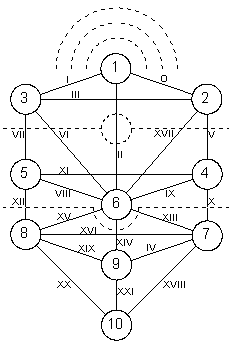Kabbalah originally developed entirely within the realm of Jewish thought and kabbalists often use classical Jewish sources to explain and demonstrate its esoteric teachings. These teachings are thus held by followers in Judaism to define the inner meaning of both the Hebrew Bible and traditional Rabbinic literature, their formerly concealed transmitted dimension, as well as to explain the significance of Jewish religious observances.
Traditional practitioners believe its earliest origins pre-date world religions, forming the primordial blueprint for Creation's philosophies, religions, sciences, arts and political systems. Historically, Kabbalah emerged, after earlier forms of Jewish mysticism, in 12th- to 13th-century Southern France and Spain, becoming reinterpreted in the Jewish mystical renaissance of 16th-century Ottoman Palestine. It was popularised in the form of Hasidic Judaism from the 18th century onwards. 20th-century interest in Kabbalah has inspired cross-denominational Jewish renewal and contributed to wider non-Jewish contemporary spirituality, as well as engaging its flourishing emergence and historical re-emphasis through newly established academic investigation.
 The emanations of creation arising from Ain Suph Aur are ten in number, and are called Sephiroth (סְפִירוֹת, singular Sephirah סְפִירָה, "enumeration"). These are conceptualised somewhat differently in Hermetic Qabalah to the way they are in Jewish Kabbalah. See Sephirot for the Jewish conceptualisation.
The emanations of creation arising from Ain Suph Aur are ten in number, and are called Sephiroth (סְפִירוֹת, singular Sephirah סְפִירָה, "enumeration"). These are conceptualised somewhat differently in Hermetic Qabalah to the way they are in Jewish Kabbalah. See Sephirot for the Jewish conceptualisation.From Ain Suph Aur crystallises Kether, the first sephirah of the Hermetic Qabalistic tree of life. From Kether emanate the rest of the sephirot in turn, viz. Kether (1), Chokhmah (2), Binah (3), Daath, Chesed (4), Geburah (5), Tiphareth (6), Netzach (7), Hod (8), Yesod (9), Malkuth (10). Daath is not assigned a number as it is considered part of Binah or a hidden sephirah.
Each sephirah is considered to be an emanation of the divine energy (often described as 'the divine light') which ever flows from the unmanifest, through Kether into manifestation. This flow of light is indicated by the lightning flash shown on diagrams of the sephirotic tree which passes through each sephirah in turn according to their enumerations.
Each sephirah is a nexus of divine energy and each has a number of attributions. These attributions enable the Qabalist to form a comprehension of each particular sephirah's characteristics. This manner of applying many attributions to each sephirah is an exemplar of the diverse nature of Hermetic Qabalah. For example the sephirah Hod has the attributions of; Glory, perfect intelligence, the eights of the tarot deck, the planet Mercury, the Egyptian god Thoth, the archangel Michael, the Roman god Mercury and the alchemical element Mercury. The general principle involved is that the Qabalist will meditate on all these attributions and by this means acquire an understanding of the character of the sephirah.
Malkuth the kingdom, sphere ten, represents the physical reality of solids, liquids and gasses, the physical body, matter, energy, space and time. Its colours are citrine, olive, russet and black.

Yesod the foundation, sphere nine, is concerned with subconscious feelings, dreams and automatic (uncontrolled) instincts associated with life. Its colour is violet and its planet, the Moon.
Hod, glory, is sphere eight. It represents intellect, reason, logic, science and mathematics, clean-cut precision and blacks and whites with no in-betweens. Its colour is orange and its planet, Mercury.
Netzach, victory, is the seventh sphere. It symbolizes feeling, emotion, the non-quantifiable, opinions (rather than facts), the arts and an infinity of shades of grey. Green is its colour and Venus its planet.
Tiphereth, beauty, is sphere six. It is concerned with balance, moderation, realism, liberalism, the route to the appreciation of a power greater than man and open-mindedness. Its color is rose-pink flecked with gold and its planet is the Sun.
Geburah, strength, severity is the fifth sphere. Its realm is destruction and violence which is often right (e.g. the punishment of evil) but must be applied with reason or it can lead to senseless destruction and unjustified violence (e.g. the atom bomb, crime etc.). This sphere is essential for reform and progress, its color is red and its planet, Mars.
Chesed, mercy, is sphere four. Its concern is giving without receiving, protectiveness, generosity and parent or grandparent-like qualities. In excess this sphere will bring loss of independence and determination. Its color is blue and its planet is Jupiter.
The extremes of Geburah and Chesed are balanced by Tiphereth.
Binah, understanding, is sphere three. It is the form that is energized by, receives and understands the wisdom of Chokmah. Crimson, black and brown are its colours and Saturn, its planet.
Chokmah, wisdom is the second sphere. It is the energizing force and basic wisdom given shape by Binah. Its colours are blue and grey.
 Kether, the crown, is the first sphere. It represents God, absolute perfection, the infinite, supreme ultimate. Its color is pure brilliance.
Kether, the crown, is the first sphere. It represents God, absolute perfection, the infinite, supreme ultimate. Its color is pure brilliance. At the head of Kether is Ain (nothingness), Ain Soph (limitlessness) and Ain Soph Aur (limitless light). Between Kether and Tiphereth lies Daath, the hidden sephira. It represents the bridge over the abyss separating divinity from the not quite divine.
Hermetic Qabalists see the cards of the tarot as keys to the Tree of Life. The twenty-one trumps and the fool are often called the "Major Arcana" or "Greater Mysteries" and are seen as corresponding to the twenty-two Hebrew letters and the twenty-two paths of the Tree; the ace to ten in each suit correspond to the ten Sephiroth in the four Qabalistic worlds; and the sixteen court cards relate to the classical elements in the four worlds. While the sephiroth describe the nature of God, the paths between them describe ways of knowing God.